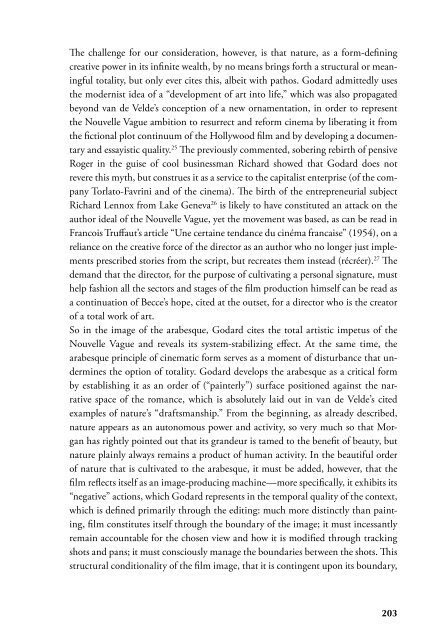The Death and Life of the Total Work of Art – Henry van de Velde and the Legacy of a Modern Concept
ISBN 978-3-86859-261-0
ISBN 978-3-86859-261-0
Create successful ePaper yourself
Turn your PDF publications into a flip-book with our unique Google optimized e-Paper software.
<strong>The</strong> challenge for our consi<strong>de</strong>ration, however, is that nature, as a form-<strong>de</strong>fining<br />
creative power in its infinite wealth, by no means brings forth a structural or meaningful<br />
totality, but only ever cites this, albeit with pathos. Godard admittedly uses<br />
<strong>the</strong> mo<strong>de</strong>rnist i<strong>de</strong>a <strong>of</strong> a “<strong>de</strong>velopment <strong>of</strong> art into life,” which was also propagated<br />
beyond <strong>van</strong> <strong>de</strong> Vel<strong>de</strong>’s conception <strong>of</strong> a new ornamentation, in or<strong>de</strong>r to represent<br />
<strong>the</strong> Nouvelle Vague ambition to resurrect <strong>and</strong> reform cinema by liberating it from<br />
<strong>the</strong> fictional plot continuum <strong>of</strong> <strong>the</strong> Hollywood film <strong>and</strong> by <strong>de</strong>veloping a documentary<br />
<strong>and</strong> essayistic quality. 25 <strong>The</strong> previously commented, sobering rebirth <strong>of</strong> pensive<br />
Roger in <strong>the</strong> guise <strong>of</strong> cool businessman Richard showed that Godard does not<br />
revere this myth, but construes it as a service to <strong>the</strong> capitalist enterprise (<strong>of</strong> <strong>the</strong> company<br />
Torlato-Favrini <strong>and</strong> <strong>of</strong> <strong>the</strong> cinema). <strong>The</strong> birth <strong>of</strong> <strong>the</strong> entrepreneurial subject<br />
Richard Lennox from Lake Geneva 26 is likely to have constituted an attack on <strong>the</strong><br />
author i<strong>de</strong>al <strong>of</strong> <strong>the</strong> Nouvelle Vague, yet <strong>the</strong> movement was based, as can be read in<br />
Francois Truffaut’s article “Une certaine tendance du cinéma francaise” (1954), on a<br />
reliance on <strong>the</strong> creative force <strong>of</strong> <strong>the</strong> director as an author who no longer just implements<br />
prescribed stories from <strong>the</strong> script, but recreates <strong>the</strong>m instead (récréer). 27 <strong>The</strong><br />
<strong>de</strong>m<strong>and</strong> that <strong>the</strong> director, for <strong>the</strong> purpose <strong>of</strong> cultivating a personal signature, must<br />
help fashion all <strong>the</strong> sectors <strong>and</strong> stages <strong>of</strong> <strong>the</strong> film production himself can be read as<br />
a continuation <strong>of</strong> Becce’s hope, cited at <strong>the</strong> outset, for a director who is <strong>the</strong> creator<br />
<strong>of</strong> a total work <strong>of</strong> art.<br />
So in <strong>the</strong> image <strong>of</strong> <strong>the</strong> arabesque, Godard cites <strong>the</strong> total artistic impetus <strong>of</strong> <strong>the</strong><br />
Nouvelle Vague <strong>and</strong> reveals its system-stabilizing effect. At <strong>the</strong> same time, <strong>the</strong><br />
arabesque principle <strong>of</strong> cinematic form serves as a moment <strong>of</strong> disturbance that un<strong>de</strong>rmines<br />
<strong>the</strong> option <strong>of</strong> totality. Godard <strong>de</strong>velops <strong>the</strong> arabesque as a critical form<br />
by establishing it as an or<strong>de</strong>r <strong>of</strong> (“painterly”) surface positioned against <strong>the</strong> narrative<br />
space <strong>of</strong> <strong>the</strong> romance, which is absolutely laid out in <strong>van</strong> <strong>de</strong> Vel<strong>de</strong>’s cited<br />
examples <strong>of</strong> nature’s “draftsmanship.” From <strong>the</strong> beginning, as already <strong>de</strong>scribed,<br />
nature appears as an autonomous power <strong>and</strong> activity, so very much so that Morgan<br />
has rightly pointed out that its gr<strong>and</strong>eur is tamed to <strong>the</strong> benefit <strong>of</strong> beauty, but<br />
nature plainly always remains a product <strong>of</strong> human activity. In <strong>the</strong> beautiful or<strong>de</strong>r<br />
<strong>of</strong> nature that is cultivated to <strong>the</strong> arabesque, it must be ad<strong>de</strong>d, however, that <strong>the</strong><br />
film reflects itself as an image-producing machine—more specifically, it exhibits its<br />
“negative” actions, which Godard represents in <strong>the</strong> temporal quality <strong>of</strong> <strong>the</strong> context,<br />
which is <strong>de</strong>fined primarily through <strong>the</strong> editing: much more distinctly than painting,<br />
film constitutes itself through <strong>the</strong> boundary <strong>of</strong> <strong>the</strong> image; it must incessantly<br />
remain accountable for <strong>the</strong> chosen view <strong>and</strong> how it is modified through tracking<br />
shots <strong>and</strong> pans; it must consciously manage <strong>the</strong> boundaries between <strong>the</strong> shots. This<br />
structural conditionality <strong>of</strong> <strong>the</strong> film image, that it is contingent upon its boundary,<br />
203


















